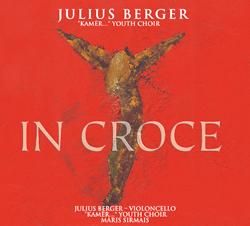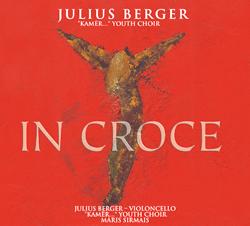
Julius Berger – Kamēr… Youth Choir: In Croce
Artists: Julius Berger, Kamēr… Youth Choir
Title: In Croce
Catalogue No.: SM 120
Release: 03.03.2008
Description
Alfred DelpThe works of this recording signalizes the way of the Human Cross by Affliction and Light. The sound of terrestrial Sein is increased by the Cross, as Beethoven says. If we accept our Cross or admit this music, life-donating “Morning Air” (Jean Paul) will capture, support and comfort us. This music is a gift of God!
Julius Berger, February 2008
The programme of “In Croce” is not a memento mori. It is not intended as a reminder that life is finite or that death is inseparable from existence because it puts a symbolic limitation on life. Artists have always pondered over ways of “emotionally translating” rather abstract trains of thought and making them comprehensible to their fellow beings.
One of the contemporary composers who have taken up this theme is the Norwegian Knut Nystedt. His Stabat Mater op. 111 is inspired by old church music like Gregorian chant and at the same time gains its force from the dialogue between soloist and mixed choir.
A farewell to the world with a work for solo cello entitled “Abschied” (parting) was vouchsafed to the composer Bertold Hummel, who died on August 9, 2002. Just days before his death, Hummel completed a richly contrasting piece, “which in its brevity is deeply moving by virtue of animated, simple and relieving strength”, as Berthold Hummel’s son Stefan aptly notes. For Julius Berger, who was responsible for the Berlin premiere on September 9, 2002, it means an “inward view into the last thoughts of a human being”.
The fact that the process of establishing one’s artistic identity can be a lifelong pursuit is shown by the works of the Estonian composer Arvo Pärt. The melodic and rhythmic models which gave rise to the music of the spheres in the Nunc Dimittis for mixed choir presented here, though those models also recall the polyphony usual to the Viennese Classical School.
Like the works of many of her colleagues who were born in the USSR in the nineteen-thirties (cf. Arvo Pärt), those of Sofia Gubaidulina cannot be assigned to any particular style or school. Gubaidulina originally thought of entitling her Ten Preludes for solo cello “Ten Etudes”, because they were intended for teaching purposes – concentrating on the emotional approach to the instrument, however, rather than on technique. Vladimir Tonkha, the cellist who premiered the Preludes in Moscow in 1977, persuaded the composer to change the title. They are after all studies in expression rather than technique, as the 5th Prelude shows.
Metaphorically speaking, the reason why Samuel Barber (1910-1981) chose to arrange the second movement of his String Quartet op. 11 of 1936 for string orchestra in the ensuing years and use the same opus number was that he wanted to create an oil painting from the pastel picture. The radiant culmination of the work could only gain in force. The Adagio uses an elegiac theme with a gradually rising motif at its core. Optimism is repeatedly confronted with resignation, but always returns in heightened form. This steady wave motion finally leads to the climax, which is followed by a melancholy epilogue.
Giya Kancheli was born in 1935 in Tiflis. The almost ten-minute cello solo “Having Wept” dedicated to Mstislav Rostropovich traces a psychologically well observed set of emotions; while the true fit of weeping is over, conflicting emotions – as it were as echoes – still well up: rage – sorrow – emptiness.
Few composers have been exposed to such severe reproach from his fellows as John Tavener. “Svyati” for mixed choir and cello, which Tavener composed in 1995, lays emphasis on the moment in the Orthodox Christian liturgy at which a bereaved family takes leave of one of their number with a kiss. The end of this liturgy signifies – as Julius Berger rightly says – “that the doors of the new room, the timeless room of eternity, now open”.
Tracklist
02 “Abschied” für Violoncello Solo – BERTOLD HUMMEL
03 “Nunc” Dimittis für gemischten Chor – ARVO PÄRT
04 Präludium Nr. 5 “Sul Ponticello – Ordinario – Sul Tasto” – SOFIA GUBAIDULINA
05 “Agnus Die” für gemischen Chor nach dem Adagio aus dem Streichquartett h-moll bearbeitet von S. Barber – SAMUEL BARBER
06 “Nach dem Weinen” für Violoncello Solo – GIJA KANTSCHELI
07 “Svyati” für gemischten Chor und Violoncello – JOHN TAVENER

